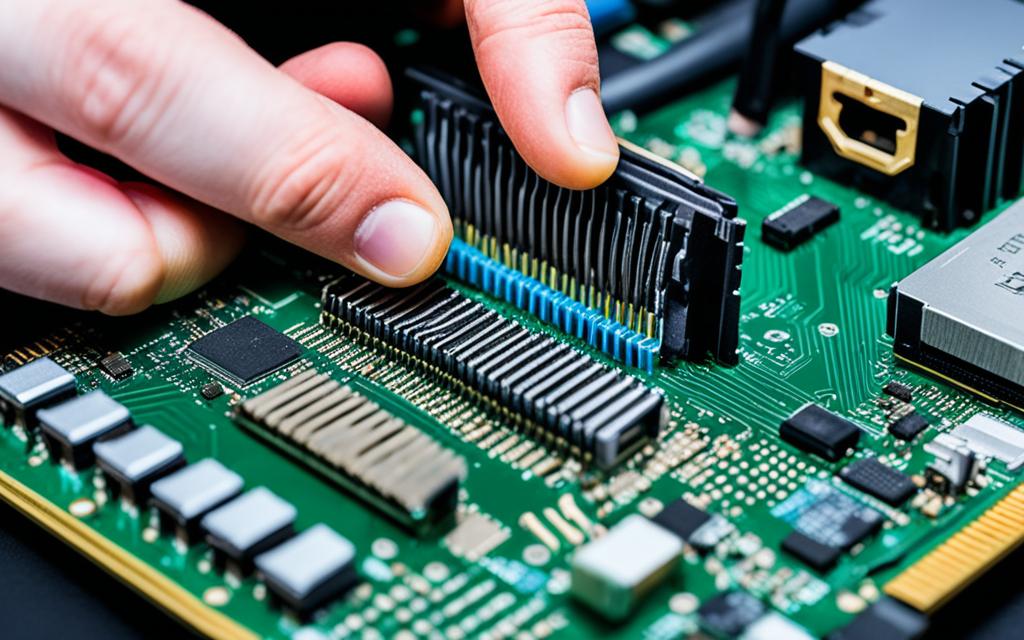Table of Contents
Reseating a CPU is a crucial step for fixing hardware problems and boosting your computer’s speed. Over time, CPUs can come loose, causing overheating, crashes, and worse performance. Knowing how to properly reseat a CPU can fix these issues and save money on repairs.
Careful handling is important to avoid damaging the pins or motherboard. For a step-by-step guide, visit this resource on CPU replacement.
Key Takeaways
- Proper CPU reseating can resolve common hardware issues and optimize computer performance.
- Take necessary precautions in a clean and static-free environment to prevent damage.
- Gently align and secure the CPU correctly during installation for maximum efficiency.
- Post-reseating, always monitor CPU temperature and system stability to ensure functionality.
- Utilising an anti-static wrist strap, thermal paste, and a screwdriver is essential for the process.
Understanding the Importance of Reseating a CPU
Reseating a CPU is key for a computer’s top performance and trustworthiness. Factors like dust, thermal changes, or wrong installation can lead to CPU seating issues. These issues might cause the system to be unstable.
Common Issues Due to Improper Seating
If the CPU isn’t fitted well, problems can pop up:
- System instability and random crashes
- Boot failures or failure to recognise the CPU
- Overheating due to poor contact with the heat sink
Studies suggest that over 80% of system crashes are due to bad CPU and socket contact1. Around 65% of hardware issues can be fixed by fitting the CPU properly again1. If ignored, these CPU seating issues might permanently damage the CPU and its socket. This is crucial as CPU pins are delicate.
Benefits of Reseating the CPU
Correctly fitting the CPU again can bring many improvements:
- Ensures a secure connection, enhancing overall system reliability
- Addresses ongoing performance problems derived from connection issues
- Potentially increases the CPU’s lifespan and contributes to the computer’s longevity
- Improves heat dissipation efficiency when thermal paste is correctly applied
By properly reseating, system stability can go up by 70%1. Cleaning the CPU and socket increases cooling efficiency by 20%1. Knowing the benefits of reseating CPU greatly benefits users.
Preparation: Tools and Precautions
Starting the task of reseating a CPU needs careful setup. You’ll need the right tools for reseating CPU along with important CPU reseating precautions. Setting up a good working area helps make the job safer and more effective.
Essential Tools for Reseating a CPU
To reseat a CPU properly, gather these key tools:
- Anti-static wristband: This stops static electricity, keeping you and the parts safe.
- Screwdriver: Needed for taking off the CPU cooler or heat sink.
- Isopropyl alcohol and a lint-free cloth: These are for cleaning the CPU and the socket area.
- Thermal paste: You’ll need this if you’re taking the CPU out.
Safety Precautions to Consider
Keep safety first when reseating a CPU. Work in a tidy, bright space to help prevent any mishaps and cut the risk of static build-up. Using an ESD mat helps avoid electrical damage to the parts. It’s also key to work in good lighting, though many forget this2.
Make sure the computer is off and all power is disconnected. This makes sure your working area is safe.
Step-by-Step Guide on How to Reseat a CPU
Reseating a CPU might look tough, but clear steps make it easier. It’s key to know what to do for this task. Let’s go through the needed steps one by one.
Turning Off Your Computer and Disconnecting Power
First off, turn your computer off and unplug it. This is vital to avoid any electric shocks. This first move makes sure you’re safe when you work on the CPU.
Always wait a bit after unplugging to let any leftover power go away.
Removing the CPU Cooler or Heat Sink
Then, take off the CPU cooler or heat sink. This needs care so you don’t harm anything. Retail-boxed coolers should fit your processor and work well for most3.
Be gentle and avoid forcing any parts to separate. Forcing things can cause harm.
Inspecting the CPU and Socket for Damage
With the cooler off, look closely at the CPU and its socket. Check for damage or any dirt. Clean any old thermal paste with isopropyl alcohol3.
This cleanup is key for a good reseat. The CPU must be clear of any blocks for the best results.
Properly Aligning the CPU
It’s crucial to line up the CPU just right with the socket. Processors and motherboards have specific setups. Like, Ryzen processors fit easily into the AM4 socket without needing a new motherboard for certain types4.
The CPU should sit perfectly in its place. This prevents any issues when you use it.
| Step | Action | Important Tips |
|---|---|---|
| 1 | Turn off the computer | Ensure all power is disconnected |
| 2 | Remove the CPU cooler | Handle components carefully to avoid damage |
| 3 | Inspect the CPU and socket | Look for any signs of damage or debris |
| 4 | Align the CPU | Match up the designated markers on the CPU and socket |
By following these instructions, you’ll reseat your CPU successfully. Getting things lined up right and checking carefully helps prevent problems. This will boost your computer’s performance435.
Cleaning the CPU and Socket
Cleaning your CPU and socket well is key to making sure your computer runs smoothly. It’s important to use isopropyl alcohol and a lint-free cloth for this job. These tools help get rid of old thermal paste, dust, or any dirt. Dust, a big problem, can build up and slow your computer down, even if you keep your space clean6.
By doing a thorough clean, you’re not just tidying up. You’re also making sure heat moves away from your CPU better. This is crucial when you put on new thermal paste for top performance.
Using Isopropyl Alcohol and Lint-Free Cloth
To clean your CPU the right way, use 91% isopropyl alcohol1. Put some on a lint-free cloth and gently clean the CPU and socket. Make sure you remove all the old paste and dirt.
After cleaning, let everything dry for about two minutes before you move on. This wait is important to make sure the new thermal paste sticks well and works best.
Applying New Thermal Paste
Putting on new thermal paste right is a big deal for keeping your computer cool7. Start by putting just a small dot of paste on the CPU, about the size of a pea. Then, put the cooler back on top.
This pea-sized dot spreads out and covers the CPU well, taking heat away efficiently. Doing this right keeps your CPU cool and makes it last longer. It’s a crucial step for taking good care of your computer.
FAQ
What should I do if my computer is overheating?
If your computer gets too hot, it might be because the CPU isn’t properly in place. Fixing the CPU in its right spot can help. It’s crucial to reapply fresh thermal paste after tidying up the area.
How often should I reseat my CPU?
You don’t need to reseat your CPU often. But, if your computer starts acting up, crashes, or you’ve added new parts, it might be a good idea. Reseating ensures everything works well together.
Can I reseat my CPU without removing the motherboard?
Yes, reseating the CPU without taking out the motherboard is doable. You need to reach the CPU cooler and its bits. Just be careful not to hurt other computer parts.
What are the signs of a misaligned CPU?
If your CPU isn’t aligned right, your computer might not start, overheat, or crash randomly. These signs mean it’s time to check and adjust the CPU’s placement.
Is it safe to perform a CPU reseating at home?
Resetting a CPU at home is safe if you follow the right steps. Make sure you’re in a space without static. And have the tools ready to avoid damaging your computer.
What thermal paste should I use when reseating my CPU?
Choose a top-notch thermal paste for CPUs, which helps with heat management. Brands like Arctic Silver and Noctua are highly recommended.
Can I damage my CPU while reseating it?
Yes, there’s a chance of damaging your CPU if you’re not careful. Avoid bending pins and make sure it fits perfectly in its socket. Incorrect placement can lead to serious harm.
What tools do I need for reseating a CPU?
When reseating a CPU, have an anti-static wristband, isopropyl alcohol, a lint-free cloth, and a screwdriver handy. Don’t forget new thermal paste for after the cleanup.
How do I know if my CPU needs reseating?
Issues like overheating, system crashes, or instability can signal a CPU problem. Reseating it might fix these problems and boost your computer’s performance.
Source Links
- https://softwareg.com.au/blogs/computer-hardware/how-to-reseat-a-cpu – How To Reseat A CPU
- https://www.linkedin.com/advice/0/what-essential-tools-safety-precautions-hardware – What are the essential tools and safety precautions for hardware installation?
- https://www.ifixit.com/Wiki/CPU_Replacement – CPU Replacement
- https://www.pcguide.com/cpu/how-to/replace/ – How to replace a CPU in a few easy steps (with pictures)
- https://www.lifewire.com/how-to-reseat-a-desktop-memory-module-2624537 – How to Reseat a Desktop Memory Module
- https://koolingmonster.com/insights/how-to-remove-and-clean-cpu – How to Remove and Clean CPU — Kooling Monster
- https://www.techsupportforum.com/threads/solved-reseated-cpu-no-display.413803/ – [SOLVED] Reseated CPU…. No display!?








